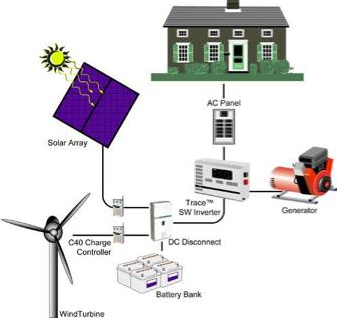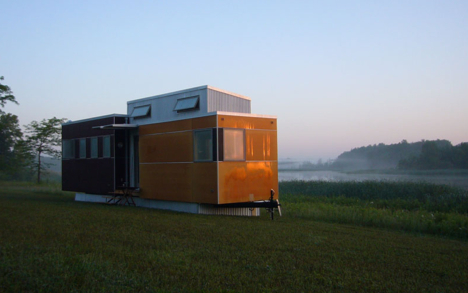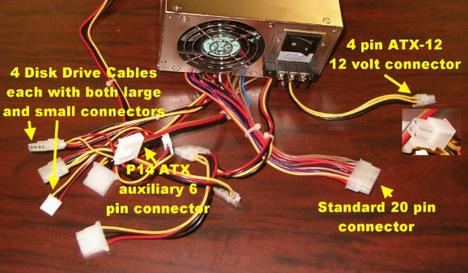
Edison was right; direct current is better than alternating current. Tesla and Westinghouse won the current wars, because it was easy to transform into different voltages without electronics, and they needed high voltages, which travel longer distances in smaller wires than low voltage.
Our current system is based on big, central power plants like Niagara Falls shown above, that pump out high voltage (as much as 400,000 volts), step it down to 22 thousand volts for distribution at street level, then down to 110/220 for distribution to our houses. At every step, there are transmission losses; as much as 10% of the electricity transmitted by the power plant is lost on the way. The losses are higher in AC than in DC because it grounds so easily; according to the Economist, DC distribution is far more efficient. (Treehugger here)
And then we get to our homes and offices....

...where there is a 110VAC outlet every 12 feet on our wall, switched outlets in our ceilings, all feeding expensive copper wires back to a central panel. And what is plugged into almost every one? Wall warts, transformers converting to a variety of voltages keyed to specific small appliances and electronics. For we now live in an electronic world, and almost everything we use other than vacuum cleaners and kitchen appliances are now running on DC Of course there is no standard of wall wart; every computer, lamp, radio or LCD TV has a different size and voltage. And every wall wart wastes energy in the process.

Lighting, now mostly incandescent needing lots of power, is going low voltage DC as we convert to LED and CFL; every fixture and even bulbs are filled with rectifiers and transformers to convert the power to low voltage, using resources in the manufacturing, and wasting energy in the operation.

For those who want to reduce their consumption and generate a little power of their own with a solar panel or wind turbine, standard practice is to run the 12 DC volt output through an inverter to change it to 110 AC for distribution through the existing 110V wiring. Of course the inverter is not 100% efficient and what are we doing at 90% of the electric outlets? Plugging in a wall-wart and converting it back to low voltage.

When he was designing the MiniHome, Andy Thomson thought this was dumb, and chose all of his lighting to run off 12VDC, cutting off the transformers and wiring it directly to the batteries. He found a Creative sound system that ran at 12V and cut off the wall-wart. The inverter broke and he barely noticed, because everything in the joint but the microwave oven could run off 12VDC.

The Google boys, Sergei and Larry, think this is dumb too.
Engineers at Google, tired of running tens of thousands of computers
with inefficient power supplies, have proposed a new standard for
"high efficiency power supplies for home computers and servers" based
on everything running on 12 volts only. They say that it would save 40
billion kwh over three years, worth $5 Billion. Founder Larry Page
complained about this last year: ďIím going to just plead with all of
you, letís get the power supply problems fixed, or letís get all these
devices talking togetherĒ
John Laumer has noted here that 12 Volt appliances are easier to supply alternate emergency power if you are knocked off the grid by a hurricane or other disaster.
It is time for our codes and our wiring to reflect this, shall we say, transformation. It is time for big steps:
1) Develop a universal standard around 12 volt dc for all electronics. Enough of this silliness that makes every wall wart a different voltage. There will still be different sizes as there are different power requirements, but agree on one voltage.
2) Develop a standard wall plug or distribution system for 12 volt DC. It is ridiculous that the only standard plug for this voltage is the automotive cigarette lighter.
3) Provide a secondary wiring system in all new houses at 12V DC based on the new plug.
4) Revise our current wiring codes to reduce the number of 110V outlets and circuits required. Now most electrical codes demand outlets every 12 feet, in every ceiling, duplex outlets in kitchens. Copper is expensive and its mining is destructive; if there is 12VDC wiring then an outlet per room for the vacuum cleaner is all that is needed. That way, there can be dual systems in a house without any more copper than is needed now.
12VDC power needs no childproofing, no wall warts, creates no EMF and
makes adding incremental sources like solar and wind much easier.
Let's make it the standard.
Contrary to the Economist article, AC at higher voltages loses less power than DC over the same distances, thanks to the equation P = V*(I squared). Using higher voltages and lower amps is superior to the reverse.
Also, when the DC/AC War was being fought, people didn't have solar panels or windmills that generated electricity. Finally, with regards to all the different electrical standards, etc., companies create electronics products first, and THEN worry about a power source. Electronics engineers don't start out with a standard power source and then ask "What can we build around this?"
I fail to see the thrust of your article, other than that you begin with the assumption that big centralized power plants are inherently "bad". I propose that this kind of setup won't change for the next century or more.
LA: the thrust of the article has less to do with transmission issues than it does about the waste within our houses by over-wiring for obsolete technology. It would not be a stretch to have electronic engineers agree on a common voltage and build around it.